
The demand for a ₹9,000 minimum monthly pension under the Employees’ Pension Scheme (EPS)-1995 has gained widespread attention across India. Thousands of EPFO (Employees’ Provident Fund Organisation) pensioners are calling on the central government to raise the pension amount from the current minimum of ₹1,000 to a more sustainable and dignified sum. This plea is not new, but it has recently picked up pace, especially amid rising inflation and increased cost of living.
For millions of retired workers who spent decades contributing to the country’s workforce, the current pension barely covers essential expenses. Let’s explore what this pension demand is about, why it matters, and what the future could hold for India’s pensioners.
Understanding the EPS-1995 and EPFO
The Employees’ Pension Scheme (EPS) was introduced in 1995 by the EPFO to provide social security to employees in the organized sector after retirement. It applies to employees who are members of the Employees’ Provident Fund (EPF) and have completed at least 10 years of eligible service.
Key Features of EPS-1995
- Monthly pension after retirement at age 58.
- Minimum service of 10 years required.
- Lifelong pension for the member and family pension after their death.
- Funded by employer contributions (8.33% of the employee’s basic pay).
Despite its noble intentions, the scheme has faced criticism due to its low pension payouts.
Why Are Pensioners Demanding ₹9,000?
The current pension of ₹1,000, which has been stagnant since 2014, does not match today’s inflationary pressures and rising living costs. According to the Reserve Bank of India (RBI), the average inflation rate over the last decade has hovered between 5% to 7% annually, effectively reducing the purchasing power of pensioners.
What Does ₹1,000 Cover in 2025?
To put it simply, ₹1,000 a month may not even cover:
- Basic groceries for a single person.
- Monthly medicines or doctor’s visits.
- Electricity and water bills.
This makes it nearly impossible for retirees to live independently without financial stress.
The Push for ₹9,000
The demand to raise the minimum pension to ₹9,000 is backed by various pensioners’ associations and supported by former EPF contributors. Here’s what they’re asking for:
1. Increase in Minimum Pension
Raise the pension to ₹9,000 per month to ensure a basic standard of living.
2. Dearness Allowance (DA)
Pensioners also want DA to be added to their pensions, just like it is for government employees, to keep up with inflation.
3. Free Government Healthcare Services
With old age often comes higher healthcare needs. Free or subsidized government healthcare can ease the financial burden.
4. Inclusion in Food Security Act
Adding pensioners under the National Food Security Act (NFSA) can provide subsidized food grains.
5. Regular Pension Revision Mechanism
A periodic review mechanism, linked to inflation or wage index, is necessary to avoid stagnation in pension rates.
6. Awareness and Education
Many pensioners are unaware of their entitlements. Creating awareness through workshops and digital platforms can help retirees access benefits fully.
Government’s Position
As of now, the central government has not officially responded to the fresh round of demands. However, multiple representations have been made by:
- National Agitation Committee (NAC)
- Various state-level pensioners’ organizations
In previous statements, the Ministry of Labour and Employment cited financial limitations as a key reason for not increasing pensions substantially.
For updates, you can regularly check the EPFO Circulars and Notifications.
What Could This Mean for Working Professionals?
If you’re currently employed and contributing to EPFO, this debate might seem distant, but it directly affects your future financial planning. Here’s why:
- Low pension yields could mean you need to invest more in PPF, NPS, or mutual funds.
- Higher pension payouts may mean increased employer contributions in the future.
- Policy reforms could change how your retirement corpus is managed.
How to Plan for Retirement
Regardless of pension reforms, it’s essential to build a solid retirement plan. Here are five tips:
1. Start Early
The sooner you start, the more you benefit from compounding.
2. Diversify Investments
Don’t rely solely on EPF. Look at NPS, mutual funds, stocks, and fixed deposits.
3. Track Inflation
Your retirement plan should outpace inflation.
4. Review Annually
Make adjustments every year based on market changes.
5. Get Professional Advice
Consider talking to a Certified Financial Planner (CFP).
6. Utilize Retirement Calculators
Use tools like the NPS Calculator to estimate how much you need to retire comfortably.
International Comparison
To put India’s pension system in context, let’s compare it briefly with other countries:
- United Kingdom: Offers a basic State Pension of ~GBP 203.85/week (2023), indexed to inflation.
- United States: Social Security provides average retirement benefits of $1,827/month (2023).
- Australia: Age Pension plus superannuation allows retirees a sustainable income based on contributions.
India’s EPS falls short in providing a livable income, highlighting the need for urgent reforms.
FAQs
Q1. What is the current EPFO minimum pension?
The current minimum pension under EPS-1995 is ₹1,000 per month.
Q2. Who is eligible for EPS-1995 pension?
Employees who have completed 10 years of service and are members of EPFO.
Q3. Will the pension amount increase soon?
There is no official confirmation yet, but demands and protests are ongoing.
Q4. Can I check my EPS balance online?
Yes. Visit the EPFO Member Portal to access your pension details.
Q5. How much pension will I get after retirement?
It depends on your service period and average salary during your last 5 years of service.








